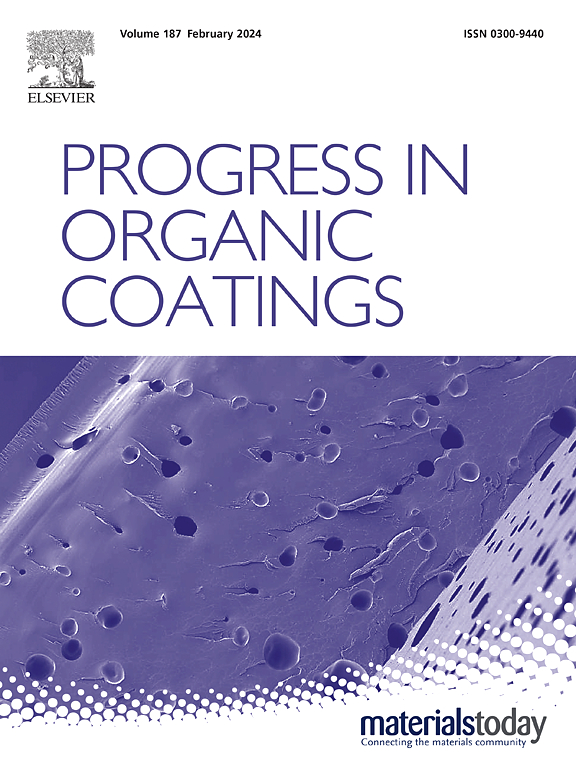Carborane hybrid epoxy resins with excellent thermal stability and neutron shielding property
IF 7.3
2区 材料科学
Q1 CHEMISTRY, APPLIED
引用次数: 0
Abstract
The thermal resistance of epoxy resins was limited, which hindered their application in nuclear facilities. Constructing a C-B hybrid crosslinked network using carborane improved the material's thermal properties. In this study, 1, 2-dichloromethyl-o-carborane (CBCl2) was synthesized for the first time, serving as an intermediate to synthesize N-methyl-1,3-propylenediamine-o-carborane (Et-CBNH2) for the first time. This novel approach broadened the synthesis of carborane derivatives. Et-CBNH2, as a curing agent, constructed a C-B hybrid crosslinked network, significantly enhancing the material's thermal resistance through mechanisms such as O-radical capture, protective layer formation, and promotion of graphitization. The material exhibited a 27.36 wt% increase under nitrogen and a 35.47 wt% increase under air in residue at 800 °C. The maximum decomposition temperature increased from 550 °C to 750 °C, with 16.59 % of the protection rate of carbon atom after thermal degradation at 750 °C in air. Furthermore, introducing the carborane structure into the networks greatly increased the glass transition temperature (Tg) by 115.58 °C. The neutron shielding properties of the material were significantly enhanced due to simultaneous enhancement of H and B atoms, which traditional methods could not achieve. This work expanded and optimized the synthesis pathway of carborane derivatives, imparting multifunctionality to epoxy resin and enhancing its various properties, thereby ensuring the safety of epoxy resin in nuclear facilities.
具有优异热稳定性和中子屏蔽性能的碳硼烷杂化环氧树脂
环氧树脂的耐热性有限,阻碍了其在核设施中的应用。用碳硼烷构建C-B杂化交联网络改善了材料的热性能。本研究首次合成了1,2 -二氯甲基-邻碳硼烷(CBCl2),并首次作为中间体合成了n -甲基-1,3-丙二胺-邻碳硼烷(Et-CBNH2)。这种新方法拓宽了碳硼烷衍生物的合成。Et-CBNH2作为固化剂,构建了C-B杂化交联网络,通过o自由基捕获、保护层形成、促进石墨化等机制,显著提高了材料的耐热性。在800°C时,该材料在氮气条件下增加了27.36% wt%,在空气条件下增加了35.47% wt%。最高分解温度从550℃提高到750℃,750℃空气中热降解后碳原子保护率为16.59%。此外,在网络中引入碳硼烷结构使玻璃化转变温度(Tg)提高了115.58℃。由于H原子和B原子同时增强,材料的中子屏蔽性能显著提高,这是传统方法无法实现的。本工作扩展和优化了碳硼烷衍生物的合成途径,赋予环氧树脂多功能性,提高了环氧树脂的各种性能,从而保证了环氧树脂在核设施中的安全性。
本文章由计算机程序翻译,如有差异,请以英文原文为准。
求助全文
约1分钟内获得全文
求助全文
来源期刊

Progress in Organic Coatings
工程技术-材料科学:膜
CiteScore
11.40
自引率
15.20%
发文量
577
审稿时长
48 days
期刊介绍:
The aim of this international journal is to analyse and publicise the progress and current state of knowledge in the field of organic coatings and related materials. The Editors and the Editorial Board members will solicit both review and research papers from academic and industrial scientists who are actively engaged in research and development or, in the case of review papers, have extensive experience in the subject to be reviewed. Unsolicited manuscripts will be accepted if they meet the journal''s requirements. The journal publishes papers dealing with such subjects as:
• Chemical, physical and technological properties of organic coatings and related materials
• Problems and methods of preparation, manufacture and application of these materials
• Performance, testing and analysis.
 求助内容:
求助内容: 应助结果提醒方式:
应助结果提醒方式:


